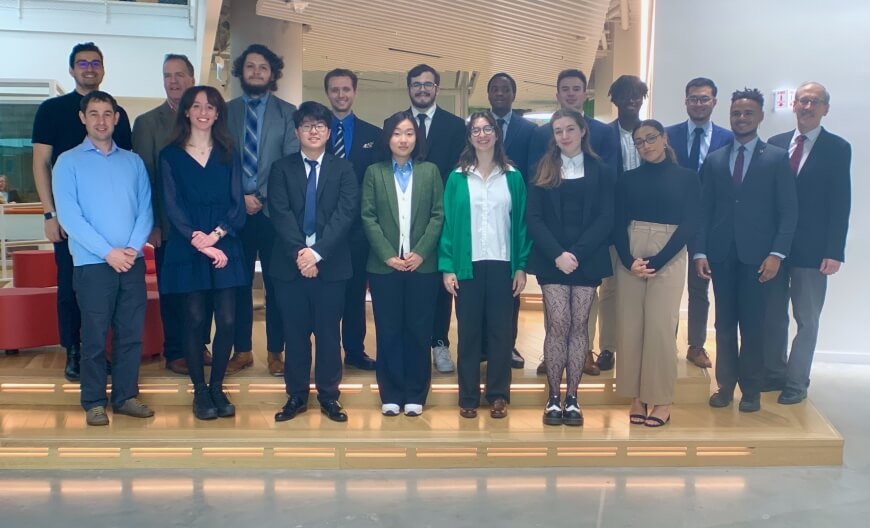News
Third-year SEAS students researched carpet recycling as their semester-long project in “ES96: Engineering Problem Solving and Design Project.” (Matt Goisman/SEAS)
It’s hard to see the carpets under our feet as a major environmental risk. Yet over four billion tons of carpet are thrown away every year in the United States. This can negatively impact the climate in multiple ways: overcrowded landfills, dangerous chemicals and plastics leaching into soil or water, or an incineration process that turns the plastics into heat-trapping greenhouse gasemissions.
Third-year students at the Harvard John A. Paulson School of Engineering and Applied Sciences (SEAS) analyzed existing state legislation and devised community awareness programs to promote carpet recycling for their Spring 2023 class, “ES96: Engineering Problem Solving and Design Project.” Under the direction of Robert Howe, Abbott and James Lawrence Professor of Engineering at SEAS, the students worked with client BASF, a world leader in chemical production whose goal was to increase its access to recycled raw materials.
“In most states there’s a complete lack of infrastructure for any type of carpet recycling,” said Soy Choi, project lead and mechanical engineering concentrator at SEAS. “We really put a lot of time into learning how we set up the recycling infrastructure, increase consumer awareness, make collection more feasible, set up the facilities and get the government to legislate and subsidize each step in the process.”
Students were divided into four teams, each of which looked at this challenge from a different angle. Nick Laws, a mechanical engineering student, led the Industry Overview team, which researched how carpet is produced and eventually disposed of, and ranked commercial carpet manufacturers based on the recyclability of their products. Another team tackled Stakeholder Analysis, which analyzed all the different industries and organizations involved in the carpet production and disposal process. Adam Reid, a mechanical engineering concentrator, and Alvin Yao, a bioengineering student, led the Policy team, which focused on existing policies in California and New York.
“Something I looked into specifically was different methods of carpet disposal, from throwing it away to incineration to gasification,” Reid said. “We wanted to research why some processes are defined as recycling and some aren’t. With incineration, you’re burning all this plastic, which is a lot of CO2, and obviously you’re not getting usable material out of it. The goal was to draft recommendations to bring to BASF that could then be presented to, for instance, a state legislature.”
New York’s policies are so new that data on their effectiveness isn’t yet available, so California’s policies, and its affiliation with the Carpet America Recovery Effort non-profit, became central to the research. From there, it fell to Choi and the Community Outreach team to determine how much retailers and consumers take advantage of the program.
“Awareness, from both consumers and retailers and producers, is very important,” Choi said. “Most people aren’t aware that carpet recycling is an option, even in California. So, we tried to address that through different tactics such as posters and websites.”
Before ever building or coding anything, students spend weeks researching and defining the exact problem they can address, and the stakeholders their solution must take into consideration. They then have to devise a solution that can be delivered by the end of the semester.
“It’s a break from classes where it’s just lessons, office hours and problem sets,” Reid said. “The crux of ES96 is the structure – how we do research, find solutions to a problem, present that information and make it into a set of requirements and deliverables for next week.”
Along with that structure, ES96 students also learn a number of essential interpersonal skills. Seventeen students worked on the carpet recycling project, making it the largest engineering project most had worked on since coming to Harvard, and they had to integrate many different personalities, academic backgrounds, and concentrations. Reid now uses the teamwork and interpersonal skills he developed in the class every day as a summer intern at General Motors in Michigan.
“You really don’t get this in other engineering classes,” Reid said. “A week ago, I was with one of my systems teams, and they were trying to reduce the amount of meeting minutes they had each week. That meeting about having fewer meetings turned into an hour-long conversation. We had the same conversations in ES96, about how we could better structure the class for more effective meetings.”
For Choi, the biggest skill she developed was communication. She conducted more than 80 interviews for the project, covering a wide range of stakeholders that included carpet consumers, retailers, lobbyists, legislators, and non-profit directors. Over time, she developed the ability to change her language to suit the background of whomever she interviewed.
“I realized it’s almost like speed dating,” Choi said. “I had to sell this whole project and get them engaged, and at the beginning I wasn’t good at it. Over time, I developed my own spiel and figured out how to deal with unique people and personalities, how to match with how they talk and engage with others in order to get the most information out of them. I became much more detailed about reading their expressions and tones, which I didn’t used to pay attention to. I think my interpersonal skills have increased tremendously, and I don’t think I would’ve gotten that in any other engineering class at Harvard.”
The students presented their strategies for outreach and legislation to BASF in May.
SEAS and BASF launched the BASF Advanced Research Initiative at SEAS in October 2007, which later evolved into the Northeast Research Alliance, a collaboration between Harvard, BASF, the Massachusetts Institute of Technology and the University of Massachusetts Amherst. BASF was also the client for a Fall 2021 semester of ES96, which focused on removing microplastics from drinking water.
Topics: Academics
Cutting-edge science delivered direct to your inbox.
Join the Harvard SEAS mailing list.
Press Contact
Matt Goisman | mgoisman@g.harvard.edu



